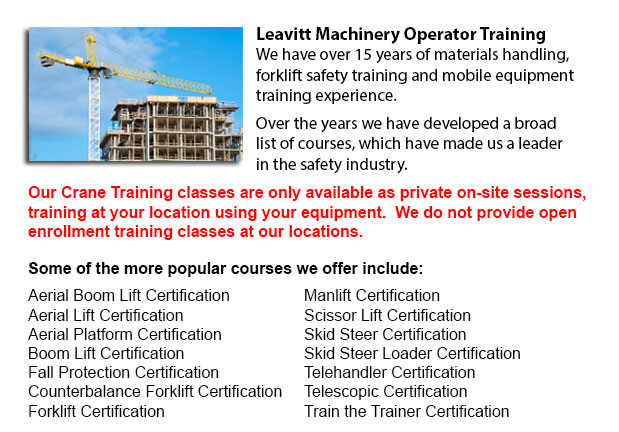
Sudbury Crane Certification - The Crane Certification training program includes subject matter suggested by industry regarding the safe and efficient operation of cranes. People training will know the following: pre-operational, operational and post operating requirements; how to identify cranes and their component parts; how to determine overall lift capacity; rigging components and inspection/rejection criteria; and needs specific to the work location where the individuals training will be operating.
The requirements that should be done before operating a crane like for example assigning authority for the pre-operational check; carrying out the sequential pre-operational check based on the manufacturer's specifications or specifications certified by a professional engineer; checking the log book for comments; checking the work place for obstacles and hazards; checking hooks, chains, cables, safety latches and crane movement; ensuring the proper functioning of operational controls; and knowing how to make sure that the crane's disconnect switch/isolator is properly functioning.
Operational requirements consist of identifying responsibilities and roles, and determining the need for a formal lift plan. Individuals training would know how to carry out a hazard assessment associated to environmental situations, physical conditions and staff. Subject matter includes determining when to seek competent support, the safest route and destination of loads, and load weight and centre of gravity.
Individuals training should be able to identify an over-capacity lift, in addition to be able to pick correct rigging machine, select load restrictions, and to determine the safe location for the crane to work from. Trainees will review both site-specific and universal crane signals for lifts, and methods for loading, traveling and lifting. Correct maintenance habits will also be included.
The person training would undergo an examination to test their knowledge of emergency response techniques for various conditions, specifically mechanical or electrical failures. They will be asked to describe parking and shut down procedures for safety and security, to follow lock out and tagging techniques, and to explain why near misses are reported and recorded to the appropriate person. Log book records should be maintained.
The person training would learn the particulars of rigging, and know the authority and responsibility for rigging. They would learn to identify the different kinds of rigging, the load capacity ratings and storage procedures.
Post-operational requirements include entering defects or deficiencies, service and maintenance history within the log book, according to provincial, federal and state codes requirements.
Site-specific requirements could be included into the safety training program based on the employer's requirements.
-
Wheel and Track Loader Training in Sudbury
Lift trucks are obtainable in several different models that have different load capacities. The majority of average forklifts used in warehouse environment have load capacities of 1-5 tons. Bigger scale units are utilized for heavier loads, like for... More -
Sudbury Aerial Lift Certification
Sudbury Aerial Lift Certification - Aerial Lift Certification is for individuals who requires an in-depth understanding of aerial lift safety. Inspectors and operators, supervisors, maintenance workers and construction craftsmen must perform a traini... More -
Sudbury Forklift Certification Schools
Sudbury Forklift Certification Schools - Within North America, forklift certification is mandatory, making forklift training programs necessary for both the company and their employees working as forklift operators. Forklift training focuses on healt... More -
Sudbury Boom Lift Operator Training
Sudbury Boom Lift Operator Training - A cherry picker refers to a type of aerial work platform. Cherry pickers include a platform or bucket at the end of a hydraulic lifting system. The device is likewise called a man lift, boom lift, basket crane or... More -
Sudbury Telehandler Certification
Sudbury Telehandler Certification - Telehandler certification programs are both for operators who have some experience driving a standard forklift and for those with no experience. The real-world training offered by these courses produces graduates w... More -
Operator Safety Training, Re-Qualification Training, In-House Instructor Training in Sudbury
Lift trucks are utilized in just about all industrial construction sites and in warehouse operations and in boat yards. The reach feature of a lift truck is a vital component used in several applications like for example when a shelving system is bei... More -
Crane / Overhead Crane / Self-Erect Crane / Truck Mounted Crane / Hydraulic Cranes Training in Sudbury
Bridge cranes or overhead cranes are a type of industrial material handling crane making use of a line and hook apparatus which runs on a horizontal beam running along two widely separated rails. Lots of overhead cranes could be seen in a long factor... More -
Sudbury Forklift Safety Training
Sudbury Forklift Safety Training - Anyone who wants to operate a lift truck should take a forklift safety training course in order to become a certified forklift truck operator. There are a variety of ways to obtain forklift training. Programs are pr... More

Forklift Certification Sudbury
TOLL FREE: 1-888-254-6157
Sudbury, Ontario
forkliftcertificationsudbury.com
Email Us
About Us


